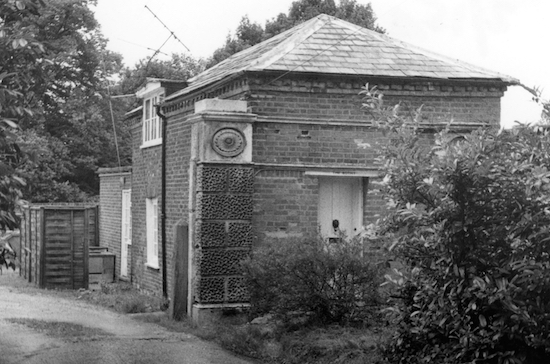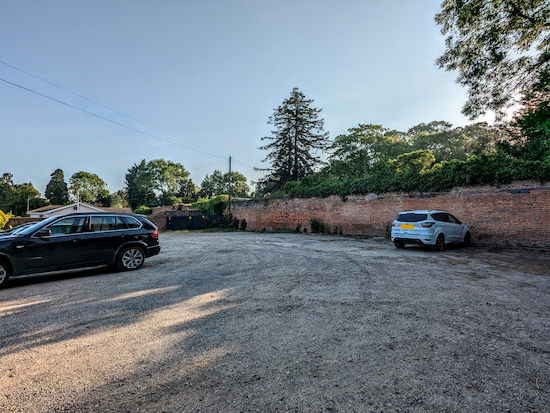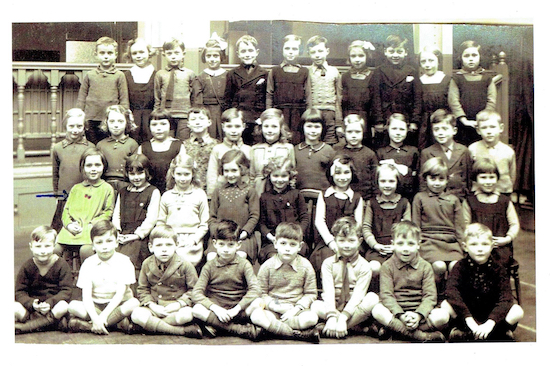The following collection of memories of life in North Mymms during WWII was sent to us by Theodora Straker (nee Schwarzschild), who contacted the North Mymms History Project (NMHP) from New Zealand offering to share her wartime experiences. The original written memories have been slightly edited in places with comments added by the NMHP in italics and enclosed in parentheses. These additions are in order to add relevant information. Throughout the piece we have added maps, images, and links where we felt appropriate.
The story of 'Dora Alphabet'
My name was Theodora Schwarzschild, and I was born in Munich in 1932. Because of Hitler coming to power life was becoming very dangerous for the Jewish community so we fled to England in 1938. We almost left it too late.
A short while later my parents rented a house in Finchley and I was sent to Highgate Primary School. After a few weeks all the parents were asked to attend a meeting only to be told that all the children were to be evacuated.
Soon after that my older sister Bettina and I found ourselves sitting in a train with a large luggage label attached to our coats. We also had another little girl called Brenda the same age as my sister.
It was not a long journey before we arrived at Brookmans Park Station and were deposited on the platform.
(The video below does not cover the stories of those evacuated to North Mymms, but it does explore the reasons behind the decision to evacuate children from British cities during WWII and some of the implications that the evacuation had for the families of the children and those who hosted the evacuees.)
We were met by a very efficient woman who handed us over to a young middle-aged lady and gentleman. She told us that this was Mr and Mrs Bryan who were going to take care of us for the duration of the war.
Actually I had no idea what was really going on as I still had not learnt any English. However we could not have been placed with anyone kinder than they turned out to be.
The Bryan family had a large Austin car and we drove to the top of Brookmans Avenue where they had a roomy and comfortable house. It was called 'Bradwell' and it was 100 Brookmans Avenue.
 |
| Postcard of Brookmans Avenue in the 1930s Image from the Peter Miller Collection |
 |
| 100 Brookmans Avenue Photograph taken in June 2023 by the NMHP |
(The Stephens family who gave Theodora a fountain pen were possibly related to Dr Henry Stephens (1796–1864), the inventor in 1832 of an indelible "blue-black writing fluid" which was to become famous as Stephens' Ink.)I am still a little mystified as I can never remember Brookmans Park as what I would call an English village; it just seemed to be a few streets, Brookmans Avenue being the most prominent.
 |
| The Ordnance Survey (OS) map showing Brookmans Avenue published 1936 Image courtesy of the National Library of Scotland Click here for a larger version |
It was in a large old and very cold house run by two ladies. The photograph at the top of this page is of us at the school. The picture must have been taken during summer as I remember it was quite the coldest place I had ever been. For lunch we all had to help with peeling, scrubbing and cleaning vegetables for making vegetable soup or whatever was available. The school was down a little lane just a few minutes walk from the Bryan's. Moffats Lane rings a bell.
(Theodora is talking about Moffats Prepatory School which was housed in what was probably once part of Moffats House Home Farm and which was adjacent to Moffats House on Moffats Lane. Part of the building was later converted into residential and became 60 Moffats Lane. This was demolished in the 1980s and a new house built in its place. )
 |
| Moffats School from the south - 1930s Photograph gifted by Ron Kingdon, part of the Images of North Mymms Collection |
 |
| The old school building from the front - 1980s Photograph by Peter Dalling, part of the Images of North Mymms Collection |
 |
| Moffats School circled in red on the Ordnance Survey map of 1936 Image courtesy of the National Library of Scotland Click here for a larger version |
 |
|
The site where Moffats School stood is where 60 Moffats Lane is now Photograph taken in 2023 by the NMHP |
(In his book 'North Mymms Schools & their Children 1700-1964' - which is published on this site - Peter Kingsford wrote about the schooling of the evacuated children in 'The Promised Land 1939-1964'.
"Even before it started, during the Munich crisis, 153 children from London were billeted in the parish, though they soon returned. The parish council resolved that "We in North Mymms Parish do not think that this Parish is a fit place to bring children into". This opinion had no effect, for children came again in the real crisis of war, from two London schools, Highgate Mixed and Infants council school and a Roman Catholic school in Chelsea.
"Fit place or not, the parish did its duty by the evacuated children. When the air raid trenches had been dug and the school windows blacked out, the buildings were ready for the evacuees. Their head teachers publicly thanked the school managers, teachers, billeting officers and foster parents of North Mymms for their kindness and generosity in the upheaval.
"The school children, both local and evacuees, became part timers, the local children occupying the schools in the afternoons, while the evacuees had the mornings, with an overflow in the scout hut in Dixons Hill Road. No less a person than John Newsom, county education officer found time to visit the parish and confirmed the arrangement. It was improved after a few months. The Highgate children went to Moffats, Brookmans Park; the preparatory school there had been evacuated to a place of greater safety. The Roman Catholic girls attending Water End took their lessons in the scout hut. The middle classroom at Water End was still, however, occupied by the Highgate infants."
When children were evacuated from London, local resident, Marjorie Tether, took in two brothers aged 4 and 6 years old. She wrote about Brookmans Park Refugees in the booklet 'North Mymms Reminiscences'as follows: " The boys went to school at Moffats House School, which had originally been a boarding school for boys who were evacuated to Devon. The house was divided, one half for the Catholics from Chelsea and the other half for a council school in Islington.")I had my seventh birthday in July and the war had just started. I am a bit hazy about the dates, but I think we must have been evacuated a few months before the actual beginning.
One of the first people we met was Mr Muddiman (I am not sure of spelling). He lived opposite and was the local warden. He fitted us with gas masks and told us how to use them. We carried them in a case round our necks at all times but never had to use them.
Later on when I had learnt English properly and went on to another school at Little Heath. We had an extra tin to carry which contained lunch which was usually a sandwich of cold mutton with a little blob of pickle and one of homemade blackberry jam. The rations were very small.
 |
| Postcard of Bradmore Green with Brookmans Avenue on the left - 1930s Image from the Peter Miller Collection |
Mrs Bryan used to read me all the traditional English children’s books and had the Children's Encyclopaedia by Arthur Mee. This was full of creative ideas and we made lots of little things with acorns, pinecones, beech nuts etc.
 |
| Volume One of the Children's Encyclopaedia by Arthur Mee Photograph courtesy of aviator2511 |
One thing I should explain is that Mrs Bryan who had three grown up daughters who had all left home but had still retained a housekeeper through all the years and who now was having to help cope with us evacuees.
Our schooling was not regular during these turbulent times and there were many days when we did not attend, but with Miss Peglar's watchful eyes we were taken out a lot to explore the countryside foraging for every edible thing we could.
Just opposite and three houses distant was the entrance to Golf Club Road. The road was flanked by horse chestnut trees, sadly not edible but great fun hunting for the biggest and strongest conker!
We went on frequent walks up to the old manor house. Next to it there was a rambling garden behind a tumble down stone wall. We used to scramble over the top and climb up what they called a tulip tree. This was supposedly a very rare tree. I am pretty sure that it was a magnolia tree and quite common now, however it was still beautiful and the colourful banks of rhododendrons in the neglected garden were magnificent.
(The NMHP has checked with Theodora, and it seems that "the old manor house" and the "rambling garden behind a tumble down wall" she refers to could be the remains of the walled garden of Brookmans Manor and The Bothy attached to the former manor. Brookmans Manor burnt down in 1891, but The Bothy remained. The stables, which now form the Brookmans Park Golf Club buildings, also survived. )
 |
| The Bothy, now part of the golf club - 1982 Photograph from the NMLHS, now part of the Images of North Mymms Collection |
 |
| Golf Club Road heading north towards the golf club Photograph taken in June 2023 by the NMHP |
(The 'bakery' that Theodora remembers was probably a house with a bread oven. Among the next buildings she would have come across along Bell Lane from the walled garden is the old Brookmans Farm cottage, which still exists, see image below, and that could possibly have had a bread oven.)
 |
| Brookmans Farm cottage Photograph from the Peter Miller Collection |
 |
| The crumbling south wall of the walled garden where Theodora played Photograph taken in June 2023 by the NMHP |
 |
| Inside what was the walled garden, now a car park, looking south Photograph taken in June 2023 by the NMHP |
 |
| The former walled garden viewed from Golf Club Road Photograph taken in 2023 by the NMHP |
The whole of this area had no boundaries. We could gather and hunt where we wished. There were wild strawberries, mushrooms, hazel nuts and lots of rose hips for syrup and elderberries for wine, this and the vegetables growing the Bryan's large garden (plus a few chickens for eggs) gave us a good and varied diet. I still make rose hip syrup, elderberry wine , bramble jelly etc and gather anything edible when available.
 |
| Folly Arch taken from Gobions Wood Photograph by the NMHP |
One Christmas the milkman gave us his oranges to put into our stockings.
When at night the air raid siren went off we all came downstairs to bunks in the entrance hall which had small windows. One eventful night a shell exploded in our back garden blowing out the upstairs windows. I did not even wake up until I heard the rattle of the tin of sweets which were saved for emergencies!
 |
| A bomb crater in the rear garden at 35 Brookmans Avenue c. 1944 Image from the NMLHS, part of the Images of North Mymms Collection |
(The image above is not the house where Theodora was evaculated but is 550m east of 100 Brookmans Avenue.)Because of our proximity to The Brookmans Park Transmitting Station we had quite a few landmines and bombs but I think they all missed their main target.
 |
| A postcard of the BBC's Brookmans Park Transmitting Station 1930s Image from the Peter Miller collection |
We also at one stage went to a Kellogg's factory and I remember being given a stuffed clown toy which I had for many years. He was not a thing of beauty but I loved him dearly.
We all had measles but there was a very nice doctor in Brookmans Park, I think he was Dr. Dwyer, and we were well looked after. My sister who was 13 by this time went back home to go to ballet school and I was the only one left.
 |
| Little Heath School, build 1907, photographed in 1987 Image from former North Mymms Local History Society (NMLHS) Part of the Images of North Mymms Collection |
 |
| Theodora's walk to school from Brookmans Avenue to Little Heath Map created on Map Hub by the NMHP Elements © Thunderforest © OpenStreetMap contributors Click on map for larger version |
(Theodora's walk from her home in Brookmans Avenue to Little Heath School would have been about 1.6 miles each way, a 3.2 mile round trip.)We walked miles in those days. Some people brought out ponies and traps. We sang WWI songs as we foraged in the woods.
 |
| Injured service personnel at the WWII hospital in North Mymms Park - 1940s Photograph gifted by Ron Kingdon, part of the Images of North Mymms Collection |
It was nearing the end of the war, but we still had the V1 Doodle Bugs and V2 rockets for another year. We lost school friends but were a resilient generation.
My parents were happy to see me back and for life to go back to normality. Throughout all the war years they were in constant touch with the Bryans who were just wonderful people.
Sadly there were a few people in Brookmans Park who would not speak to the Bryans because they welcomed German evacuees.
I have lived in New Zealand now for nearly 50 years but still have children in the UK.
 |
| Highgate Primary School 1938 - Theodora Schwarzschild in yellow Image courtesy of Theodora Straker Click on the image for a larger version |
For many years after the war we were in touch with the Bryans and their daughters. A really special family, now all left as memories.
Theodora Straker - June 2023
Comments and information welcome

If you have anything to add to this feature, or just want to add your comments, please use the comment box below.

No comments:
Post a Comment
Comments on this piece
If you have any information to add to this item, please use the comment box below. We welcome input and are keen to update any piece with new research or information. Comments are pre-moderated, so there will be a delay before they go live. Thanks
Further information
If you require any further information relating to this, or any other item, please use the contact form, because we are unable to reply directly to you via this comment box. You can access it from the 'contact us' link at the top of any page on the website, at the bottom of the right hand side of the website, or at the bottom of any page.